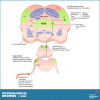What's the buzz? The neuroscience and the treatment of tinnitus
- PMID: 33769102
- PMCID: PMC8576365
- DOI: 10.1152/physrev.00029.2020
What's the buzz? The neuroscience and the treatment of tinnitus
Abstract
Tinnitus is a pervasive public health issue that affects ∼15% of the United States population. Similar estimates have also been shown on a global scale, with similar prevalence found in Europe, Asia, and Africa. The severity of tinnitus is heterogeneous, ranging from mildly bothersome to extremely disruptive. In the United States, ∼10-20% of individuals who experience tinnitus report symptoms that severely reduce their quality of life. Due to the huge personal and societal burden, in the last 20 yr a concerted effort on basic and clinical research has significantly advanced our understanding and treatment of this disorder. Yet, neither full understanding, nor cure exists. We know that tinnitus is the persistent involuntary phantom percept of internally generated nonverbal indistinct noises and tones, which in most cases is initiated by acquired hearing loss and maintained only when this loss is coupled with distinct neuronal changes in auditory and extra-auditory brain networks. Yet, the exact mechanisms and patterns of neural activity that are necessary and sufficient for the perceptual generation and maintenance of tinnitus remain incompletely understood. Combinations of animal model and human research will be essential in filling these gaps. Nevertheless, the existing progress in investigating the neurophysiological mechanisms has improved current treatment and highlighted novel targets for drug development and clinical trials. The aim of this review is to thoroughly discuss the current state of human and animal tinnitus research, outline current challenges, and highlight new and exciting research opportunities.
Keywords: channels; drug development; hearing loss; synapses; tinnitus.
Conflict of interest statement
No conflicts of interest, financial or otherwise, are declared by the authors.
Figures








Similar articles
-
Deafferentation-based pathophysiological differences in phantom sound: Tinnitus with and without hearing loss.Neuroimage. 2016 Apr 1;129:80-94. doi: 10.1016/j.neuroimage.2015.12.002. Epub 2015 Dec 19. Neuroimage. 2016. PMID: 26708013
-
Homeostatic mechanisms and treatment of tinnitus.Restor Neurol Neurosci. 2013;31(2):99-108. doi: 10.3233/RNN-120248. Restor Neurol Neurosci. 2013. PMID: 23435453 Review.
-
Neuroscience of Tinnitus.Neuroimaging Clin N Am. 2016 May;26(2):187-96. doi: 10.1016/j.nic.2015.12.001. Epub 2016 Mar 22. Neuroimaging Clin N Am. 2016. PMID: 27154602 Review.
-
Effects of frequency discrimination training on tinnitus: results from two randomised controlled trials.J Assoc Res Otolaryngol. 2012 Aug;13(4):543-59. doi: 10.1007/s10162-012-0323-6. Epub 2012 Apr 4. J Assoc Res Otolaryngol. 2012. PMID: 22476724 Free PMC article. Clinical Trial.
-
Tinnitus-related neural activity: theories of generation, propagation, and centralization.Hear Res. 2013 Jan;295:161-71. doi: 10.1016/j.heares.2012.09.010. Epub 2012 Oct 23. Hear Res. 2013. PMID: 23088832 Review.
Cited by
-
Current understanding of subjective tinnitus in adults.Eur Arch Otorhinolaryngol. 2024 Sep;281(9):4507-4517. doi: 10.1007/s00405-024-08633-w. Epub 2024 Apr 17. Eur Arch Otorhinolaryngol. 2024. PMID: 38632112 Review.
-
Cerebral venous congestion alters CNS homeostatic plasticity, evoking tinnitus-like behavior.Cell Biosci. 2024 Apr 9;14(1):47. doi: 10.1186/s13578-024-01221-9. Cell Biosci. 2024. PMID: 38594782 Free PMC article.
-
A Neuron-Like Cellular Model for Severe Tinnitus Associated with Rare Variations in the ANK2 Gene.Mol Neurobiol. 2025 May;62(5):6467-6477. doi: 10.1007/s12035-024-04674-8. Epub 2025 Jan 15. Mol Neurobiol. 2025. PMID: 39815069 Free PMC article.
-
Neuroplasticity and tinnitus: the role of Brain-Derived Neurotrophic Factor in pathogenesis and treatment.Front Neurosci. 2025 Jul 8;19:1620894. doi: 10.3389/fnins.2025.1620894. eCollection 2025. Front Neurosci. 2025. PMID: 40697272 Free PMC article. Review.
-
Theta-Beta/Gamma Coupling Identifies Bothersome Tinnitus Induced by Thalamocortical Dysrhythmia.Brain Behav. 2025 Jun;15(6):e70437. doi: 10.1002/brb3.70437. Brain Behav. 2025. PMID: 40503593 Free PMC article.
References
-
- Adams PF, Hendershot GE, Marano MA, Centers for Disease Control and Prevention/National Center for Health Statistics. Current estimates from the National Health Interview Survey, 1996. Vital Health Stat 10: 1–203, 1999. - PubMed
Publication types
MeSH terms
Grants and funding
LinkOut - more resources
Full Text Sources
Other Literature Sources
Medical

